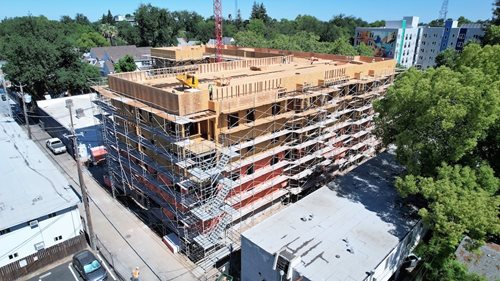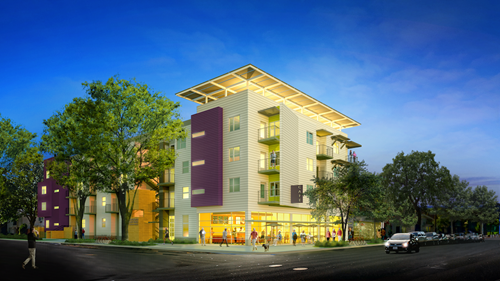Trees surround the four-story project at 16th and F Streets in Sacramento, California. On that corner, in what's known as the City of Trees, NeighborWorks network organization Mutual Housing is overseeing the construction of its first affordable, LGBTQIA+-welcoming senior housing project. The project is believed to be the first of its kind in the central valley, but leaders hope it won't be the last.
 Created in partnership with Sacramento LGBTQIA+ community leaders, Lavender Courtyard is set to start housing tenants aged 62 and older in spring of 2022. Calls from potential residents, who have watched this project ever since Mutual Housing purchased the vacant parcel of land in 2015, have been coming in since a construction crew broke ground in October 2020.
Created in partnership with Sacramento LGBTQIA+ community leaders, Lavender Courtyard is set to start housing tenants aged 62 and older in spring of 2022. Calls from potential residents, who have watched this project ever since Mutual Housing purchased the vacant parcel of land in 2015, have been coming in since a construction crew broke ground in October 2020.
"What matters most in the development of an LGBT-welcoming community is strong partnerships and connections to the community that will be served," says Roberto Jiménez, Mutual Housing's CEO. The nonprofit has found partnerships: U.S. Bank, SAGE, Enterprise Communities, The Harry and Jeanette Weinberg Foundation and the Sacramento LGBT Center. But even before that, the project was rooted in a partnership with community members.
Lavender Courtyard got its start when a group of Sacramento friends connected with Rachel Iskow, Mutual Housing's former CEO. They began discussing a plan, which became a strategy, which became a building.
James Joseph was a member of that initial group. "We could see the demand was growing for affordable housing in the downtown area,"he says. Many of his older friends were being priced out of downtown in the Lavender Heights district, where the LGBTQIA+ community had felt safe and where many LGBTQIA+ businesses had developed to support each other. The Sacramento LGBT Community Center is also in Lavender Heights. 
As costs went up, residents moved to other regions, where there were few services to assist them, Joseph says. "It was a very lonely, poor retirement, mentally and physically unhealthy."
Lavender Courtyard, which will also include units for individuals coming out of homelessness, is the antithesis of lonely and includes plans for supportive services. Access to skilled nursing and identity-affirming healthcare, as well as advocacy resources through partners, will be available.
"It's very exciting," says Joseph, who toured apartment communities in other parts of the state while working on the plan for Lavender Courtyard. "If we built another 100 units, I think they would still be filled."
Jiménez, who has been CEO of Mutual Housing since 2017, says one lesson he took from the project was the importance of trauma-informed design. "Design matters," he says. "Trauma-informed design is crucial in centering the populations who live in affordable communities – including people coming out of homelessness and LGBT elders."
A building design that feels safe, removes adverse stimuli and connects with the natural world utilizes components of a trauma-informed design. For Lavender Courtyard, that also means paying attention to lighting in the office spaces, interior paint color choices, and having planter boxes in common areas. The wrap-around services are the other part of the equation, along with keeping seniors connected to a community.
According to SAGE, an advocacy group for LGBTIA+ elders, older LGBTQIA+ individuals are more likely to live alone, which makes them vulnerable to social isolation. Many also report discrimination and fears that their sexual orientation would prevent them from getting care. LGBTQIA+ older adults are also less likely to reach out to providers, senior centers or meal programs out of fear of discrimination or harassment.
Romi Hall, NeighborWorks director of Healthy Homes and Communities, says isolation can be detrimental to the health of older Americans. "NeighborWorks network organizations work to combat that. This project promises to fight isolation, while at the same time, providing supportive care that is also becoming a fixture at many network nonprofits."
Jiménez has said the Lavender Courtyard will be a source of pride for the neighborhood and city. "And hopefully it inspires others to know that LGBTQ-affirming housing can be built outside of a major American metropolis – and be welcomed into the community."
06/23/2021

